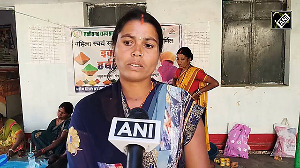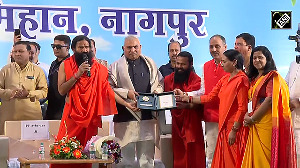 Suneel Pandey, who lives on the banks of the River Ganga in Kankhal near Haridwar, says that the disaster unfolding in Uttrakhand is shocking, but hardly surprising. This is his story.
Suneel Pandey, who lives on the banks of the River Ganga in Kankhal near Haridwar, says that the disaster unfolding in Uttrakhand is shocking, but hardly surprising. This is his story.
The divine land is going through pain inflicted by the corrupt rulers. We have seen how more than 70 dams on the Rivers Ganga, Mandakini, Alaknanda and Yamuna were built in the last couple of decades. We saw how the divine land was raped by dubious contractors.
We have seen the rampant corruption of politicians here. They allowed buildings, dharmshalas and hotels to come up recklessly around ancient shrines, on majestic mountains and on the fragile riverbed.
We have seen with horror how rich Indians who wanted to avoid the travails of pilgrimage, and invented the ‘chopper yatra’. If you ask me what should be done immediately, I would say stop the ferry of helicopters in Uttrakhand -- just to begin with. We don't really need that.
The hell with tourism! If we don’t survive, if our atmosphere is not kept clean from carbon dioxide and other dangerous gases that these choppers leave behind in the purest of pure air, then what will we do with this money? The people of Uttrakhand are scared. We live under fear.
Din-raat dar lagta hai. Paryarvaran ko kaise bigada humne? Ab pata chala. (Day and night, we live under fear. How have we managed to degenerate our environment? We know now.).
State Chief Minister Vijay Bahuguna has rightly said it’s the ‘Tsunami of Himalaya’.
According to mythology, King Kedar, who ruled in satyug (age of truth), had a dream, in which Lord Shiva guided him to this divine place. Accompanied by his daughter Vrinda, he found the Shivling (the holy symbol of Lord Shiva) where the temple stands today. The king came back, but Vrinda stayed back according to folklore, achieved nirvana there. Hence, the place is locally known as Vrindavan too.
Also Read:
LATEST PIX: Army bravehearts rescue thousands in U'khand
Kedarnath evacuated; 50,000 still stranded in Uttarakhand
45 Army, IAF choppers; 10,000 troops deployed in Uttarakhand
PHOTOS: Army plays saviour in rain-ravaged Uttarakhand
Uttarakhand tragedy: 'We prayed and waited for our fate'
The local population in Kedarnath is not that much. The shrine is managed by a committee appointed by the government. The committee is comprised of managers of temples and hotels.
Kedarnath has a nice little bazaar that sells bits and odds to tourists. The location is heavenly -- where the snow-capped mountains and the sun-kissed riverbed keep you in awe. Eight kilometers from the Kedarnath temple, there is a reservoir known as the Vasuki Tal.
At the altitude of 4,135 metres above the sea level and in the company of the magnificent mountains, nobody would have thought that a ‘sailaab’ (flood) will come one day and demolish the thousand-years-old edifices in less than an hour.
Then, on June 16 when the rains came, lots of people went inside the ancient temple because it’s built on a height. Most of them were tourists. The government claims that some 4,000 people were in and around Kedarnath shrine.
We have not been able to establish the facts, but locals say that the Vasuki Lake started overflowing and brought waters towards the temple. In addition, June 17 also saw a cloudburst. At around 6.50 am, torrential rains and the flood hit the shrine site, wrecking havoc.
Tourists sank in seconds under the massive force of water; the water also demolished many illegal structures in no time.
I have information that the ancient Samadhi of Adi Guru Shankaracharya is also flattened by the force of the swollen river. The Gadhwal Mandal Vikas Guest House in Kedarnath is also completely submerged.
Locals said that “only the top portion of the temple is intact”. The temple is full of river water. There are many bodies inside the temple.”
Pilgrims travel to Gaurikund from Haridwar by cars or bus to reach the temple. From Gaurikund, pilgrims cover the 18-kilometre stretch of narrow road on foot or on mules or in palanquins. This road is now completely washed out.
We are sure that we won’t allow the place to just go away from our life. We have to rebuild it. The pollution here is unprecedented. One can only imagine its effect on the mountains, the pure air, and the rivers and valleys.
Professor R C Sharma, an environmental scientist from the Hemvati Nandan Bahuguna University in Shrinagar, Uttrakhand, says that the devastation around Kedarnath is largely due to the cloudburst on June 17, but has raised strong concerns over the helicopter yatras at the Kedarnath site.
“The helicopters come and go around 50 times in a day. They leave behind copious amounts of gases. Never has Kedarnath been touched by carbon on such a big scale,” he says.
Sharma thinks the gases have punctured the ‘vayumandal’ (atmosphere). Sharma says the impact of tourism needs to be studied.
“Three days after the mayhem, we are worried about some 3,000 stranded tourists at Kedarnath, 10,000 at Badrinath and another 1,000 at Joshimath. Around 60,000 people are facing the aftermath of the water deluge. Some 22 army helicopters are helping the stranded. All of us are afraid. We are only talking about ‘paryavaran’ (environment),” he says.
Torrential rains, weak foundations of the mountains, shifting rivers and unprecedented impact of cloud bust have ruined us. It will take a decade to recover. It will take at least a year, as the chief minister has claimed, to restart the Kedarnath pilgrimages.
As told to Sheela Bhatt











 © 2025
© 2025